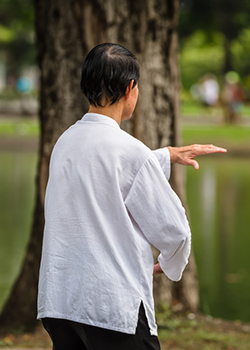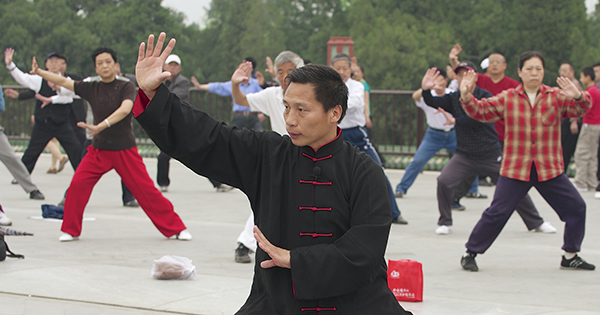
There are several ways that peripheral visual awareness is trained in Taijiquan (太極拳). For example, during push-hands (推手 tui shou) and fighting practice, schools often teach a “soft focus” on the partner or opponent’s chest. Some schools practice keeping their nose vertically above their navel, avoiding turning their heads during solo forms practice, but keeping awareness of the movements of their hands and feet; other schools turn their heads while having their eyes softly follow the direction of their lead hand. Some direct their gaze to the horizon.
In both solo and interactive practices, we want to train to have a “wide-angle” vision such that we have awareness of the whole body, from the hands to the feet. The “binocular” vision of humans is good for focusing both eyes on an object, enabling accurate depth perception, but sacrifices peripheral awareness. Our eyes are not as wide set as in prey species, like rabbits, where safety requires a wide visual awareness so that predators do not sneak up on them.
While humans are not capable of seeing behind us (rabbits can see almost 360° horizontally), we should be able to have visual awareness of about 180-200° horizontally and 125-135° vertically. About 60-70° of the horizontal visual field does not have binocular vision since only one eye can see those parts of the field. Our field of view narrows considerably when we focus intently on a single object, the so called “tunnel vision.”
A 1996 article by Steve Gallop, O.D. (J. Behavioral Optometry, 7(6):151-155) presents a case for the importance of human peripheral visual awareness, and I will extensively use information from it for this article. He gives the following definition: “Peripheral visual awareness will be considered as the ability to be cognizant of, though not distracted by, a significant amount of space/time volume relative to the particular setting and task at hand.”
More simply, peripheral vision is what we can see “at a glance,” or everything we see that we are not looking at directly. It can be viewed as being like a spider in the center of its web, sensing the entire web without focusing directly on any specific place until something touches the web.
The ability to have a wide field of visual awareness, without becoming distracted, is something that needs practice. We want to avoid tunnel vision or being overly focused on a primary detail. If we are paying too much attention to a partner/opponent’s hands, for example, we may miss knowing when they threaten us with a kick, or noticing when they are preparing to take a step.
Gallop states that “…it is the nature of our culture that emphasis is placed on the small details, not the big picture; on outcome, not process; on stasis, not change. Central/foveal vision is about static details and outcomes. Peripheral vision is about movement and process, and it is involved with detecting and understanding the big picture – the context and changes in our environment. It represents the bulk of what our world demands that we process visually.” This information on peripheral vision fits well with Taijiquan’s emphasis on change and movement.
Central vision and hard focus are more about reaching out for information, whereas peripheral vision and soft focus are more about receiving information, letting information come to us. This receptiveness should be accompanied by alert awareness since we do not want to reach the stage where we lose interest (“zone out”); we should be aware of when we stop letting new information in.
 When we practice from-contact interactions in Taijiquan, we lessen the need for vision to be the dominant information gatherer; we now get much of our information from the sense of touch (e.g., mechanoreceptors and proprioceptors) which often becomes primary. This allows us to relax and soften the eyes, and allow our peripheral vision to increase in importance. Rather than focusing on one or two things, soft focus allows us to take in more information.
When we practice from-contact interactions in Taijiquan, we lessen the need for vision to be the dominant information gatherer; we now get much of our information from the sense of touch (e.g., mechanoreceptors and proprioceptors) which often becomes primary. This allows us to relax and soften the eyes, and allow our peripheral vision to increase in importance. Rather than focusing on one or two things, soft focus allows us to take in more information.
Gallop states “It is well accepted that 20% of the fibers that make up the optic nerve go directly to the so-called lower (postural) centers in the brain rather than to visual centers, as do the other 80%. However, those 20% represent up to 80% of the area of the retina – the peripheral retina. Apparently a large amount of visual information has little to do with ‘seeing’ per se, but very much to do with being.”
Peripheral vision helps aid balance; those who have tried performing their solo forms while keeping their eyes closed will realize this. While the inner ear’s vestibular system is more critical for our sense of balance, vision does play a part. Peripheral vision is what places us into the context of our surroundings, a sense of orientation and our relationship with gravity, and this may be why balance can be affected when we move with closed eyes, although the inner ear will quickly compensate with practice.
While wide angle awareness may have evolutionary importance in protecting us from danger, modern society has trained many people to limit our visual capabilities. Gallop states: “We are typically taught early in school that we must block out all distractions and concentrate entirely on the task at hand. We quickly learn to narrow our focus to a small volume of space/time in order to carry out our required duties. This type of behavior is not innate and, in fact, requires considerable effort to achieve. Nonetheless, with repetition this becomes an automatic behavior, one that is likely to manifest any time we are engaged in some demanding task…”
As martial artists, we need to practice to overcome this behavior that has become automatic for many of us. We need to practice having a soft focus, a wide angle vision. As an optometrist, Gallop found that “While it is not at all a simple matter to maintain optimal peripheral awareness at all times, it is surprisingly easy to enhance this function enough to make a meaningful difference in overall visual performance.

Leave a Reply